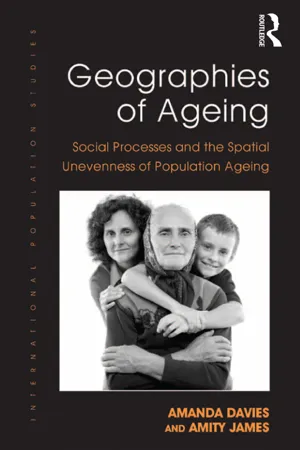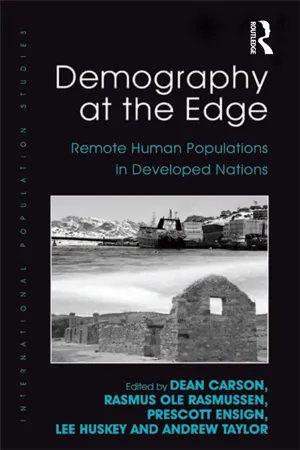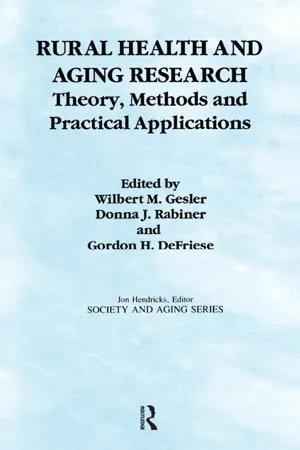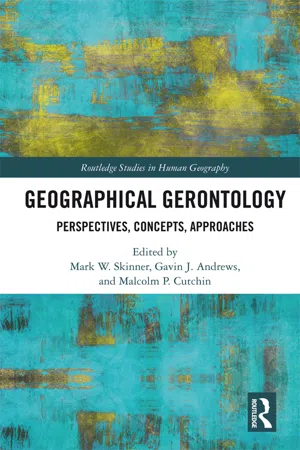Geography
Aging Populations
Aging populations refer to a demographic trend characterized by a growing proportion of elderly individuals within a population. This phenomenon is often attributed to declining birth rates and increased life expectancy. It has significant implications for healthcare, social welfare, and economic systems, as it can lead to a greater demand for elderly care and pension provisions, as well as potential labor force shortages.
Written by Perlego with AI-assistance
Related key terms
7 Key excerpts on "Aging Populations"
- As will be argued, there are in fact many different paths likely to be followed by ageing populations. These will reflect factors such as social and cultural variations across different societies, contrasting levels of resources within and between countries, differences in the speed of demographic change and contrasting attitudes towards older people and the idea of ageing. The purpose of this chapter is to review the key demographic drivers behind population ageing, setting these within the broader global context which forms the organizational framework for this book. The chapter first reviews the development of population ageing, defining in the process what is meant by the term ‘ageing societies’. It goes on to survey contrasts between different societies – both within high-income countries and in comparison with low-income countries of the global south. We will also consider gender and social class variations in life expectancy, and the rise of the very elderly population (including the increasing number of centenarians). The discussion then places population change within a sociological context, examining questions about the link between the development of ageing and individual beliefs and attitudes. Finally, the chapter considers a theme which will be returned to at various stages throughout the book: Why are ageing populations often presented as a ‘problem’? What is the historical context for this? What alternative arguments might be developed in response to such views?Population ageing in the twenty-first centuryThe ageing of populations was one of the most important developments of the twentieth century and will raise major challenges for life in the twenty-first. The proportion of the global population aged 65 and over in 1900 was 1 per cent (UK 5 per cent); in 2000 it was 7 per cent (UK 16 per cent) and by 2050 it is estimated that it will be 20 per cent, a figure that the UK is likely to reach in 2020. Population ageing refers to both the increase in the average (median) age of the population and the increase in the number and proportion of older people in the population. This change arises during the move from a demographic regime of high fertility and high mortality to one of low fertility and relatively low mortality. The former is associated with fast-growing young populations; the latter with more stable populations including a larger proportion of people in the older age groups. This process is described in the demographic transition model , derived from observations of the experiences of West European countries over the course of the nineteenth and twentieth centuries. Two clear phases are identified in this model. In the first, mortality rates decrease as a result of economic growth, improved material well-being and advances in public health. Fertility rates stay high, however, leading to a rapid increase in the size of the population, reinforced by higher survival rates through childhood and beyond. Moving into the twentieth century, a second phase unfolds, with a decrease in the number of babies being born and greater prominence and awareness of older age groups (reflected, for example, in concerns about the danger arising from ‘declining populations’ expressed in the 1930s and 1940s).1
- eBook - ePub
Geographies of Ageing
Social Processes and the Spatial Unevenness of Population Ageing
- Amanda Davies, Amity James(Authors)
- 2016(Publication Date)
- Routledge(Publisher)
This introductory chapter provided an overview of projected global ageing patterns and some preliminary comments about the spatial unevenness of these. Across the world, population ageing has been caused by a decrease in the rate of fertility. Decreased mortality rates have also influenced population ageing inasmuch as people live longer and families choose to have fewer children due to increased probability of survival through childhood. Globally, migration has not been particularly significant to patterns of population ageing (however, as we discuss later in this book migration is important to spatial patterns of ageing within countries).The key findings of this chapter are:• Across the world population ageing has occurred in a spatially variable pattern. Variability in the conditions influencing fertility and mortality in countries is a major cause of the variability in the rate of population ageing. Spatially variable patterns of ageing are expected to continue until at least 2050.• Projected ageing trends show that many countries that currently have moderately aged populations are expected to experience rapid ageing until at least 2050.• The current population age profiles are an outcome of social, economic and political factors that underpinned fertility, mortality and migration between 1910 and 1950. During this period many of the world’s countries were involved in two world wars, industrialised countries experienced economic depression and considerable population migration following each world war, and many developing countries experienced civil war and struggles for colonial independence.• In 2050, the people who will be aged 65+ are those who are currently aged between 25 and 60, or in other terms the majority of the current working age population. The fertility patterns of this population will influence future ageing trends. The savings and productivity patterns of this population will largely determine how population ageing shapes future economic growth and development.The following chapter reviews structural population ageing within countries. The discussion centres on within-country variability in spatial patterns of ageing and some of the causes for this. - eBook - ePub
Demography at the Edge
Remote Human Populations in Developed Nations
- Rasmus Ole Rasmussen, Prescott Ensign, Lee Huskey, Dean Carson(Authors)
- 2016(Publication Date)
- Routledge(Publisher)
It is not a straightforward task to document the ‘ageing’ of remote populations over time. Some specific communities and regions exhibit ageing patterns consistent with the general descriptions of demographic transitions. They face an ageing crisis associated with below replacement level fertility and limited in-migration. Other places exhibit chaotic patterns of ageing over time – in-migrants are different to out-migrants and decisions made by small groups of people in a short period of time have long lasting effects. Patterns can be arrested or reversed in short periods of time. Furthermore, the changing nature of what it means to reside somewhere and how births, deaths and migration are attached to specific populations makes interpretation of snapshots and time series data difficult.A population’s age profile is the outcome of a particular set of historical circumstances as measured at a point in time within the constraints of the measurement techniques that are available. Strange forms of population pyramids describe ‘bubbles’ and ‘craters’ that are attached to specific, often localised, historical events, as well as, to broad and persistent trends. The aim of the demographer should not be to smooth out these bubbles and craters to discover some underlying summary indicator, but to explain their existence and project their persistence. Age analysis can tell you a lot about remote populations – when life events occurred, how long they persisted and who they affected. It is understanding the detail and the dynamic nature of change, which is the interesting and important aspect of demographic analysis.References
Australian Bureau of Statistics 2009. 3201.0 – Population by Age and Sex, Australian States and Territories, June 2009 . [Online] Available at: http://www.abs.gov.au/AUSSTATS/[email protected]/DetailsPage/3201.0Jun%202009?OpenDocument [accessed: 23 March 2010].Alaska Commission on Aging 2008. Senior Population and Growth Rate by Census Area/Region . [Online] Available at: http://www.hss.state.ak.us/acoa/assets/SeniorPop2008.pdf . [accessed: 11 March 2010].Alaska Department of Health and Social Services, Alaska Commission on Aging 2007a. State Plan for Senior Services FY2008-FY2011 . [Online] Available at: http://www.hss.state.ak.us/acoa/documents/statePlanFinalFY08_FY11.pdf - eBook - ePub
Rural Health and Aging Research
Theory, Methods, and Practical Applications
- Wilbert M Gesler, Donna G Rabiner, Gordon H Defriese(Authors)
- 2019(Publication Date)
- Routledge(Publisher)
1 ].The elderly, as a broad age category, are only about one-half as mobile as the general population. Between 4 and 5 percent move across state lines in any five-year period. Indeed, roughly three-quarters of persons ages sixty and over reported having lived at the same address for at least five years during the past three censuses, making the older population residentially very stable. Nonetheless, the migration of elders has some unique features that make it worth studying, and over the past two decades, a body of descriptive demographic research has delineated many of its features [2 ].Health, of course, is one reason for persons to move in their later years. Some move because they are in good health and want to enjoy those healthy years in an amenity-rich setting; others move because of declining health and an increased need for assistance and social support [3 ].Rural populations are much smaller than those in urban areas. The study of the mobility patterns of rural elders, therefore, is a special piece of the large puzzle of old age mobility, with its own set of theoretical and methodological issues and dilemmas. Although this chapter will focus on mobility in rural populations, the larger context of retirement migration will often intrude because the theoretical and methodological problems of the general often also apply to the specific. Research examples, however, are usually drawn from rural settings.THE CONCEPTUAL CONTEXT Population Redistribution and Its ImportanceMigration is the major short-term driver of age-specific population change in small areas. It is the most volatile of the population processes of birth, death, and migration. Bohland and Rowles pointed out that the proportion of the age sixty-five and over population in the United States grew by 1.4 percent between 1970 and 1980, and yet for individual counties the decadal changes ranged from -16.5 percent to +13.5 percent [4 - eBook - ePub
Geographical Gerontology
Perspectives, Concepts, Approaches
- Mark W. Skinner, Gavin J. Andrews, Malcolm P. Cutchin(Authors)
- 2017(Publication Date)
- Routledge(Publisher)
Part IIGeographical perspectives on ageing
Passage contains an image
3 Health geographies of ageing
Janine L. WilesIntroduction
Ageing shapes, and is shaped by, geographies of health. Health geographies of ageing have moved from a biomedical emphasis on health as the absence of disease to embrace more holistic socio-ecological understandings of ageing and health in social, physical and symbolic contexts. Health geographers examine the relationship between people and their physical, social and symbolic environments. They focus on the distribution of and engagement with health, illness and a wide variety of resources for health, from the most intimate level of the body through to regional and global scales.Just as health geography is a substantive sub-discipline of social geography, health geographies of ageing are a substantive sub-theme of the geography of ageing; geography is a crucial element of the ageing process. In this chapter, I explore health geographies of ageing as a substantive research tradition, from early concerns about the health trends of older populations to contemporary concerns for how space and place impact older people’s health and health care and how older people co-experience their health and place. I address three geographical areas of spatial, relational and critical health geographies of ageing. Throughout, three key themes that define health geographies of ageing are incorporated. These themes include inequities in health geographies of ageing, the health aspects of ageing in place and attachment to place and landscapes of care, including the provision of health care and other forms of support and service for ageing adults.Spatial science geographies of ageing and health
Most spatial science approaches to ageing and health geography focus on measuring and understanding the implications of the changing distribution of ageing populations at global, regional and urban levels (Cook and Halsall, 2011; Davies and James, 2011; Moore and Rosenberg, 2001). Researchers show how trends in disease, technology and social conditions shape population ageing at these different spatial scales (Davies and James, 2011; McCracken and Phillips, 2005). They investigate patterns and especially inequalities in distributions of older people and in health outcomes and quality of life in old age (Warnes, 1999). Such information is useful in being able to indicate likely demand for a range of services and supports associated with old age and to plan for future needs ( Joseph and Cloutier, 1990; Rosenberg, 2014). - eBook - ePub
- Danny Dorling, Stuart Gietel-Basten(Authors)
- 2017(Publication Date)
- Polity(Publisher)
6 Population AgeingIn this chapter, we explore issues of ageing in greater depth and attempt to discern the extent to which the issue of population ageing really is the cataclysmic threat to states that the popular press presents it as. Firstly, we explore the underlying causes of population ageing, and briefly consider the demographic ‘levers’ which could, it is often argued, stop demographic ageing in its tracks; namely, pronatalism and/or replacement migration. Next we discuss the ways in which these underlying drivers fit into the different stages of population ageing, and describe the different ways in which population ageing is measured. While this might, at first glance, appear to be a rather dry subject, we argue that the commonest way in which population ageing is (misleadingly) measured is fundamentally linked to our entire construction (and perception) of ageing as a ‘threat’ and a ‘problem’.The dementia ‘epidemic’ is, perhaps, one of the ultimate achievements of human endeavour. More and more of us worldwide are now able to live long enough to even be able to suffer from it. This reflects the double-edged sword of population ageing – the triumph of public health and modern medicine together creating many new challenges. Our response could be either positive or negative; here, we want to try to be a little more positive. For example, the most recent evidence on dementia suggests that more recently born cohorts ‘have a lower risk of prevalent dementia than those born earlier in the past century’ (Matthews et al., 2013: 1405).Help the aged?
Population ageing is often held up as one of the greatest challenges of the twenty-first century. Indeed, it is a unifying threat that is seen as a growing problem in both post-industrial countries as well as to what are termed ‘emerging markets’, to use the often hopeful rhetoric. The hope here usually comes from those who think that in future they will be able to sell more to those markets. But an ageing population can be harder to sell goods to, or at least goods they don’t really need. When Coca-Cola flooded the world with what was largely a sugary substitute for water, the message of much of their advertising was that this was the drink for the young. A great deal of advertising is aimed at younger, more naive consumers, including children. - eBook - ePub
- Mark Novak(Author)
- 2018(Publication Date)
- Routledge(Publisher)
These trends point to lower birth rates in the future. But no one can predict the direction of future rates. For example, the increase in the birth rate in 2007 took place even though more American women work outside the home than ever before.Also, birth rates differ for various ethnic and racial groups. The Hispanic population has historically had a birth rate higher than the white population and other ethnic/racial groups. This young population will play a future role in the politics of population aging, especially in states with large Hispanic populations (e.g., California and other southwestern states).Gerontologists point to the potential for conflict between the relatively large older white population and the large younger Hispanic population. For example, this young group may resist paying for benefits to the older white population through taxes and other state subsidies.If birth rates increase, this will moderate the aging of the population. An increased birth rate will decrease the proportion of older people in the population and will lower the median age. Still, it won’t reduce the large effect of the aging Baby Boomer population on American society.The Challenges of an Aging Population
The older group will grow over the next 50 years or so, but it will not grow steadily. For example, population aging will slow and in some years will reverse itself. Myers (1990, p. 32) calls this the “metabolism of the population.”Between 1990 and 2000, for instance, the proportion of older people in the population decreased. The slow growth in the 65- to 74-year-old group accounts for this trend, but changed in the early to middle years of the 21st century when the Baby Boom cohorts entered old age. These new cohorts bring with them better health, better incomes, and a new view of later life.At the same time, a larger number of people than ever before will live into late old age. These people, some of them over 100 years old, will have unique health and social service needs. The composition of the older population (the number of younger and the number of older seniors) can tell us about the challenges the United States will face as the population ages.
Learn about this page
Index pages curate the most relevant extracts from our library of academic textbooks. They’ve been created using an in-house natural language model (NLM), each adding context and meaning to key research topics.






